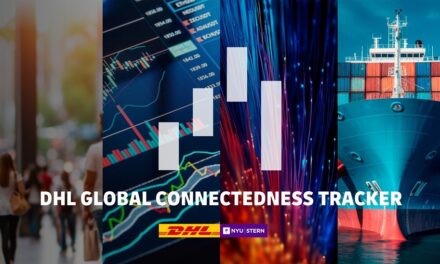
DHL research: Countries that are neither close allies of the U.S. nor of China are growing their shares of world trade

DHL and New York University’s Stern School of Business have released the new DHL Global Connectedness Tracker, updating the most comprehensive available analysis of globalisation’s state and trajectory. An extension to the established DHL Global Connectedness Report, it tracks how flows of trade, capital, information, and people move around the world.
The DHL Global Connectedness Tracker measures international relative to domestic activity on a spectrum from 0% to 100%. Currently at 25%, it shows that globalisation is holding steady at a record high, highlighting the resilience of international flows in the face of geopolitical tensions and uncertainty. This level also indicates that, despite decades of globalisation, the world is far from being completely connected.
The new DHL Global Connectedness Tracker also features tools that allow users to examine trends by region, by geopolitical alignment, and for individual countries. It also supports data and chart downloads for offline analysis and sharing.
Global trade remains a central pillar of the world economy
“The Global Connectedness Tracker shows that there are still countless opportunities for countries and businesses to expand their markets across the globe,” said John Pearson, CEO DHL Express. “While the outlines of this complex landscape remain in flux, the fundamental drivers and benefits of international engagement endure. Global trade enhances international exchange and fosters opportunities to empower individuals, businesses, and allows entire nations to flourish.”
Further, the latest data underscores the crucial role of global trade. In 2023, 21% of the value of all goods and services produced around the world was traded internationally – just shy of the all-time high of 22% first reached in 2008 and matched in 2022.
Geopolitically ‘unaligned’ countries benefit from trade shifts
Ties between the U.S. and China continue to diminish. Direct trade between the U.S. and China fell from 3.5% of global goods trade in 2016 to 2.6% in 2024 (January to July). At the same time, these numbers reflect that direct trade between the U.S. and China accounts for only a small part of world trade.
The DHL Global Connectedness Tracker also reveals that ‘unaligned’ countries that are neither close allies of the U.S. nor of China are conducting a growing share of world trade, developing new roles as connecting economies bridging geopolitical rivals. The share of trade involving countries that are not close allies of either superpower rose from 42% in 2016 to 47% in 2024, with the United Arab Emirates, India, Vietnam, Brazil, and Mexico seeing especially large trade share gains over this period.
Weighing the impact of potential new U.S. tariffs
Given a potential for tariff increases on U.S. imports and possible new trade conflicts after Donald Trump’s return to the White House, the analysis suggests caution regarding predictions that such developments would reverse globalisation. It is noted that, while actual policy changes in the U.S. remain uncertain, international trade has remained resilient through Brexit, the U.S.–China trade war, the Covid pandemic, and conflicts in Ukraine and Gaza.
“In turbulent times, it is essential to look beyond the political crossfire about globalisation to make informed decisions based on how international flows are actually developing,” said [about%3Ablank]Steven A. Altman, Senior Research Scholar and Director of the [about%3Ablank]DHL Initiative on Globalisation at NYU Stern’s Centre for the Future of Management. “While there is no guarantee that the recent resilience of global flows will continue, it highlights how companies and countries often find creative ways to preserve benefits they derive from globalisation. As long as markets stay connected, a company that unilaterally retreats from globalisation can put its competitive position at risk.”
Looking at how globalisation levels and trends vary across types of activity, the DHL Global Connectedness Tracker illustrates that information flows are the most globalised and – due to digitisation – show the largest increase in globalisation over the past two decades. People flows, such as migration and travel, by contrast, stand out for very low levels of globalisation.
Evidence against a broad regionalisation trend
Despite increased interest in producing goods closer to customers in recent years, the analysis indicates that regionalisation is not overtaking globalisation. In fact, most flows are taking place over stable or longer distances – which speaks against a broad shift towards regionalisation. During the first seven months of 2024, traded goods even traversed the longest average distance on record (4,970 km). In line with this, the share of goods trade taking place inside major world regions fell to a new low of 51%.
The DHL Global Connectedness Tracker
Regularly updated, the DHL Global Connectedness Tracker is a new extension to the renowned DHL Global Connectedness Report which has been published regularly since 2011. The November 2024 version of the Tracker analyses more than eight million data points on international flows of trade, capital, information, and people. It includes a powerful and easy to use data tool that allows customised and reliable deep dives into the state of globalisation and global trade, offering interactive online charts and convenient download options. The DHL Global Connectedness Tracker is commissioned by DHL and authored by Steven A. Altman and Caroline R. Bastian of New York University Stern School of Business.










